North Carolina is known for its beautiful trees. And, of course, where there are trees there are tree frogs! Tree frogs are small amphibians that live in trees or near bodies of water. They have long, sticky toes that help them climb and cling to surfaces.
There are several species of tree frog found in North Carolina, including the Green Tree Frog, Spring Peeper, Pine Barrens, Cope’s Gray, Squirrel Tree, Upland Chorus, Brimley’s Chorus, Ornate Chorus, Southern and Northern cricket, and more.
To let you know more about these interesting creatures, we’ve gathered 16 Tree frogs’ information that is found in North Carolina. So, keep reading to learn more about these fascinating creatures.

16 Wonderful Tree Frogs in North Carolina
The hills of North Carolina are alive with the sound of tree frogs. These tiny creatures are found all over the state, and they make a unique noise that can be heard for miles. If you’re lucky enough to live near a forest or swamp, you can hear their song any time of year. Listen closely, and you might even be able to identify the different species by their call.
There are 16 species of tree frogs in North Carolina, and they come in a variety of colors and sizes. Let’s see them all!
1. Spring Peeper
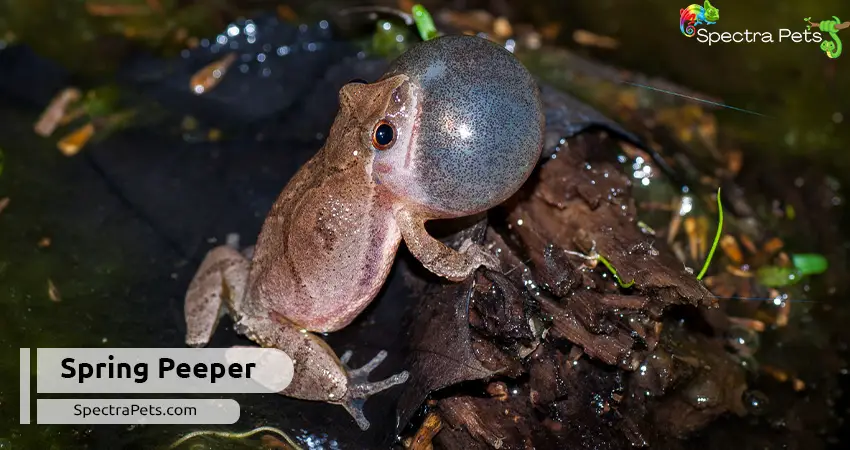
| Scientific Name | Pseudacris crucifer |
| Adult Size | 0.75″ to 1.25″ |
| Average lifespan | 2-4 years |
| Other Names | None |
| Family | Hylidae |
| Suitable for | Intermediate Frog Owner |
| Approx. Price | $10- $25 |
The Spring Peeper name comes from the fact that these frogs hibernate during winter and awaken during the early spring with their welcoming chirping call.
The Spring Peeper is a small frog that’s usually dark brown or gray in color. There are even Spring peepers that turn olive green or tan in color. Most of them have a light-colored stripe that runs down the middle of their back, and their belly is white. While females are slightly lighter in color but have a larger size compared to males.
You will find these cute guys in wetlands and forests. Ideally, these frogs like to stay in small ponds and marshes, and lay eggs and nurture their offspring in swamps. These adorable creatures love to hunt small insects like ants, spiders, flies, beetles, etc during the night and stay hidden the whole day.
2. American Green Tree Frog
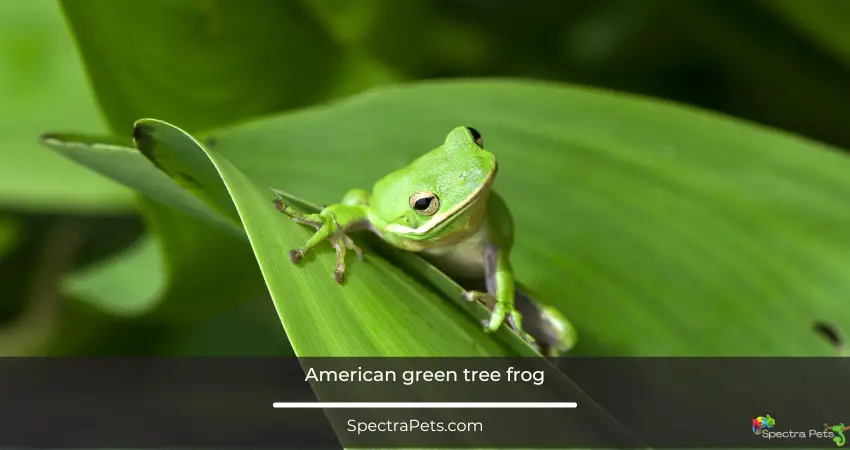
| Scientific Name | Dryophytes cinereus |
| Adult Size | 2” to 2.5″ |
| Average lifespan | 2- 6 years |
| Other Name | Green Tree Frog |
| Family | Hylidae |
| Suitable for | Intermediate level Frog Owner |
| Approx. Price | $10- $15 |
In addition to being green in color, these green frogs also become olive, and brownish-green in color. You can easily identify this cute creature by the yellow or white stripe marks on both sides of the body. However, some green tree frogs don’t possess these stripes. In such cases, you can identify them by the golden or orange flecks on their upper body.
You will usually find these average-sized amphibians in big trees. During breeding times, they love to visit small ponds, lakes, and swamps. As a nocturnal predator, this species of frog hunts at night on tree branches and hides during the day in moist areas or waterside vegetation.
Using their sticky toe pads, these insectivorous animals can easily climb trees and catch insects such as crickets, beetles, mosquitoes, and flies. The high adaptability of these small cute guys makes them popular pets.
3. Squirrel Tree Frog
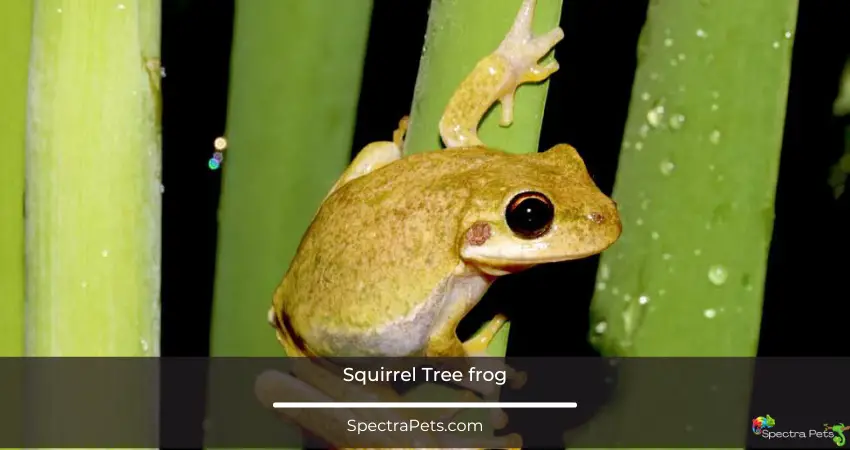
| Scientific Name | Hyla squirella |
| Adult Size | 1” to 1.5″ |
| Average lifespan | 5- 9 years |
| Other Name | Rain Frog |
| Family | Hylidae |
| Suitable for | Intermediate level Frog Owner |
| Approx. Price | $10- $12 |
These wonderful frogs create sounds like squirrels when they want to mate and that’s why people named these species of frogs the “Squirrel Tree Frog”. Some frog enthusiasts also call these frogs “Rain frogs” as they love to chirp during rainfalls.
The color of squirrel tree frogs can vary depending on the location where they are found. They can be green, brown, or yellow, but are most commonly light green. Some have stripes or spots down their sides, and a bar between the eyes. They are usually a shy species and will try to avoid being seen.
If you walk along North Carolina’s coastal plains, you’re likely to see these frogs. You will also find them near streams, swamps, and marshes too. They also love to march on tree branches, gardens, and places filled with trees, logs, and vegetation. Small insects and bugs like flies, spiders, ants, mosquitoes, etc. are their primary food.
4. Cope’s Gray Treefrog
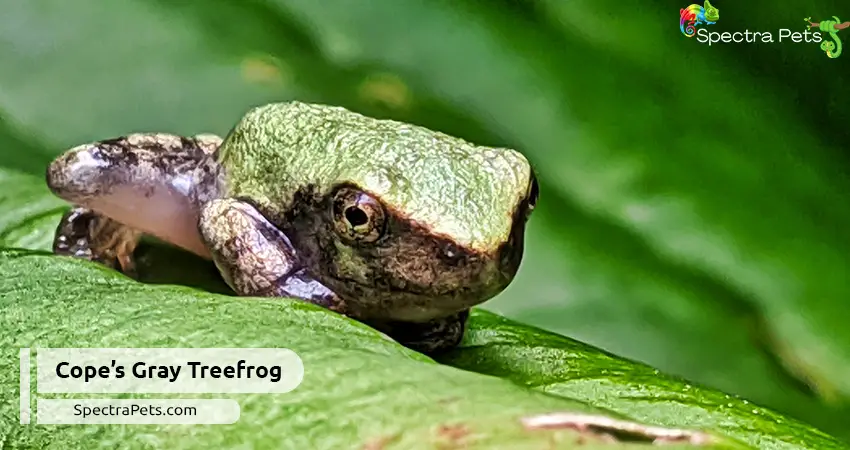
| Scientific Name | Dryophytes chrysoscelis |
| Adult Size | 1” to 1.25″ |
| Average lifespan | 7 – 10 years |
| Other Name | Southern gray treefrog |
| Family | Hylidae |
| Suitable for | Beginner level Frog Owner |
| Approx. Price | $20- $25 |
Just like Squirrel tree frogs, these frogs are also commonly seen in the coastal plain of North Carolina. Cope’s gray treefrog is endowed with high tolerance power that helps them to survive in dry and freezing cold environments.
These cute buddies are almost identical to Gray treefrogs as both types of frogs have a similar appearance and are found in the same geographical area. If the Cope’s gray frogs’ mating call weren’t high-pitched and faster than the Gray treefrog, there would be no way to distinguish them since they are both grayish green and look like tree barks.
In addition to that, Cope’s gray frogs are equipped with bright yellow to orange patches on the back of their legs that are visible when they hop. They breed between May and August and lay eggs in ponds or water bodies where predators aren’t an issue.
This opportunistic feeder loves to hunt insects such as spiders, moths, mites, flies, plant lice, and snails. They sometimes gobble up other small tree frogs too.
5. Pine Barrens Treefrog
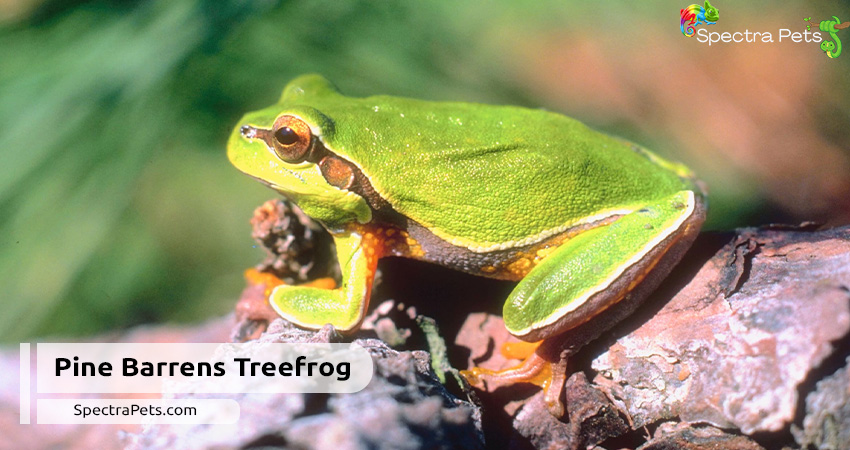
| Scientific Name | Dryophytes andersonii |
| Adult Size | 1” to 3″ |
| Average lifespan | 2- 5 years |
| Other Name | None |
| Family | Hylidae |
| Suitable for | Expert level Frog Owner |
| Approx. Price | Due to limited availability, none sells these frogs |
Introducing one of the rarest tree frogs in the United States. Unfortunately, due to habitat loss, this new world frog is on the verge of extinction. A white border runs along the sides of these green-colored frogs, which makes them fairly easy to identify. Also, the underside of their legs is orange in color, which makes them even more attractive.
You can spot one or two Pine Barrens tree frogs in the sandhills or pine forests of North Carolina. These nocturnal animals like to hide under bushes, shrubs, and bogs. However, they come out in breeding seasons and stay near freshwater pools, ponds, streams, and lakes at that time.
Their mating call sounds like the sound of “quonk” and it is repeated frequently between 10 and 20 times. As they don’t mind low pH levels, they lay eggs in acidic ponds. Like most tree frogs, these guys are also insect-eaters. Therefore, they won’t spare any flies, beetles, or ants passing through their hunting zone.
6. Pine Woods Treefrog
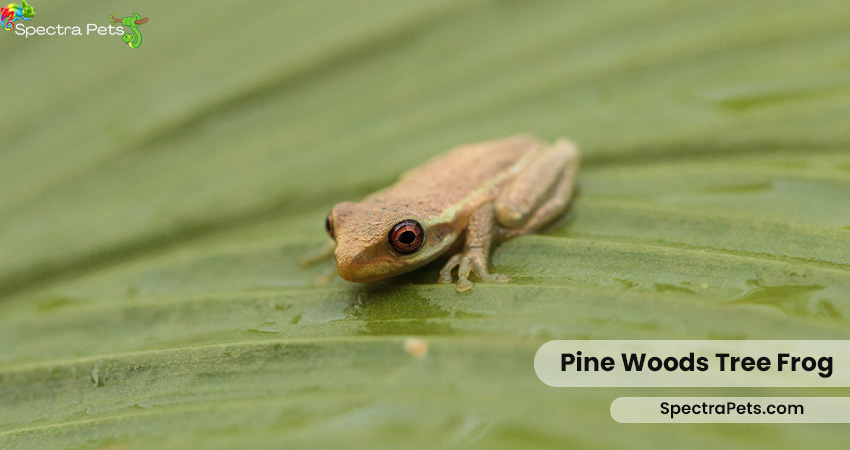
| Scientific Name | Dryophytes femoralis |
| Adult Size | 0.75” to 1.5″ |
| Average lifespan | 2- 4 years |
| Other Name | None |
| Family | Hylidae |
| Suitable for | Intermediate level Frog Owner |
| Approx. Price | $20 – $25 |
Pine Woods frog is beautiful and its symmetrical body structure are one of the things that make this creature so special. In terms of color, these little buddies may be brown, dull green, reddish-brown, or gray. In appearance, they resemble squirrel tree frogs, but a yellow, orange, or white spot on each thigh makes them distinguishable.
This tiny frog is commonly found on pine trees and Flatwoods near the coastal plains of North Carolina. You may also see them in cypress swamps too. Usually, they like to climb trees and stay up there.
However, in dry weather or cold temperature, Pine wood frogs hide inside trees, in moist cavities, and beneath rotten logs to survive. March – April to October is their ideal mating time and trees, vegetation, and shrubs located near water bodies are the best mating spots for them.
Insects such as spiders, flies, crickets, ants, and moths are its favorite food. The most concerning fact about this frog is that it is extremely sensitive to habitat change, and diverse environmental changes threaten its survival.
7. Barking Tree Frog
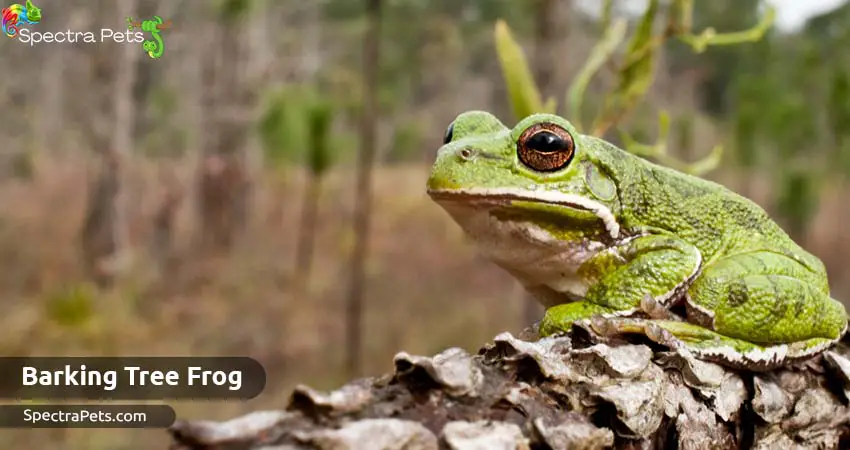
| Scientific Name | Dryophytes gratiosus |
| Adult Size | 2” to 2.75″ |
| Average lifespan | 5 – 10 years |
| Other Name | None |
| Family | Hylidae |
| Suitable for | Beginner level Frog Owner |
| Approx. Price | $15 – $20 |
Known for its explosive and raucous barking calls, the Barking Tree frog is one of America’s largest native tree frogs. These mid-sized amphibians live in eastern Piedmont and the coastal plains of North Carolina. These animals tend to live high in the trees, preferring dry Flatwoods and pine forests, but they also tend to go underground during extremely hot temperatures.
Moreover, These cute tree frogs have round heads and big bodies. They are adorned with uniform darker round spots all over their backs. This frog has skin like no other American frog. It has a thick, leathery skin that is neither rough nor warty. Also, there is a clear white line above their mouth that extends down both halves of their body.
This frog has a round, prominent toe pad that gives it an amazing appearance. Plus, a big vocal sac is found in males. This species also has a remarkable ability to change its color depending on the time of day, temperature, lighting, or surroundings. Black, gold, and brown are the colors of this frog’s eyes.
8. Gray Tree Frog
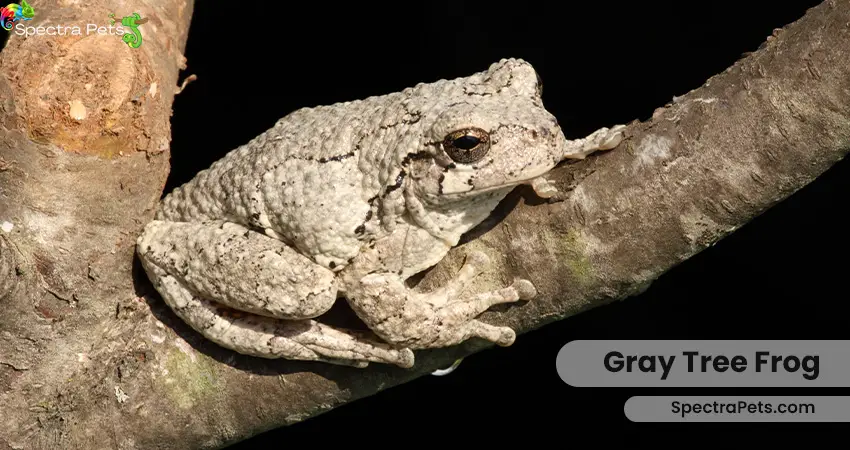
| Scientific Name | Dryophytes versicolor |
| Adult Size | 1.25″ |
| Average lifespan | 7 – 10 years |
| Other Name | Northern gray treefrog, tetraploid gray treefrog |
| Family | Hylidae |
| Suitable for | Beginner level Frog Owner |
| Approx. Price | $20 – $25 |
I know you have already heard about this frog as I have mentioned a few things about it while describing Cope’s gray tree frog. Let’s know further about this small tree-climbing master.
Not only do these frogs resemble Cope’s gray frog but also look identical to Pine Woods and Squirrel tree frogs. So, you can identify them through their mating call and slightly bigger body structures.
Like other common tree frogs, you will find them in areas loaded with trees. They prefer to stay in forests filled with debris and leaf litter. In breeding times, Gray Tree frogs go to small water bodies like ponds or streams and lay eggs. Spring is their preferable mating time.
Depending on their surroundings and behavior, they can be green to gray to brown. With bumpy skin, bright (Orange/Yellow) spots on their legs, and white spots under both eyes, these Northern gray tree frogs look exceptional.
Moreover, these nocturnal creatures can withstand pretty cold temperatures. They love to have insects such as ants, snails, mites, spiders, and plant lice as their daily meal. A grown-up gray frog can even eat small frogs.
9. Upland Chorus Frog
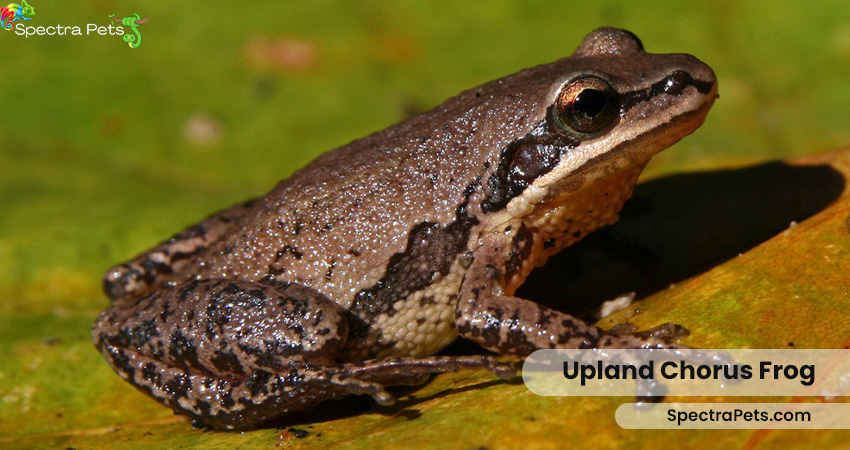
| Scientific Name | Pseudacris feriarum |
| Adult Size | 0.75” – 1.5″ |
| Average lifespan | 1 – 5 years |
| Other Name | None |
| Family | Hylidae |
| Suitable for | Intermediate level Frog Owner |
| Approx. Price | Not found |
With its greenish-gray or reddish-brown body color, the Upland Chorus frog attracts a lot of attention. Its dark stripes run through its snout to the groin which makes this animal even more eye-catching. Also, a white line on the upper lip and three rows of patches on the back help distinguish them from other frogs.
However, you will rarely encounter these Amphibians because they are very shy. If you live near the central part of North Carolina, you may see them in the coastal plain, the mountains, or Piedmont right after a session of rain. These gray guys also love to stay around flooded fields, wetlands, moist woodlands, densely vegetated small water bodies, and grassy ditches.
Though Upland chorus frogs breed throughout the year, they prefer to breed frequently in cooler times of the year. As a result, November to March is the ideal mating and breeding time for them. The females lay eggs in vegetated ponds.
Invertebrates and insects, such as ants, snails, spiders, and beetles, make up their diet and they tend to hunt at night. Males produce a “Crreeek” sound that distinguishes them from southern chorus frogs. The sound reminds me of fingers running down a comb’s teeth.
10. Southern Cricket Frog
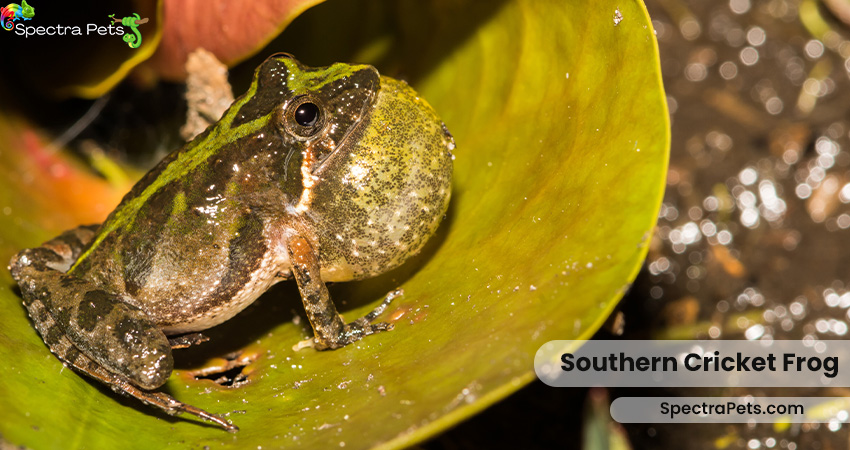
| Scientific Name | Acris gryllus |
| Adult Size | 0.75” – 1.5″ |
| Average lifespan | 5 – 10 years |
| Other Name | Southeastern cricket frog |
| Family | Hylidae |
| Suitable for | Beginner level Frog Owner |
| Approx. Price | $6 – $10 |
Meet a strange frog from the tree frog family who can’t climb trees effortlessly. So, don’t expect to see them on higher tree branches. However, you will easily find them playing near lakes, ditches, bogs, ponds, and streams. It is more likely to see them in sunny areas rather than in woodlands.
These adorable amphibians are typically gray, or brown in color, and having long hind legs with no toe pads. Although their coloration may vary slightly, some southern cricket frogs possess a distinctive orange or brown stripe across their backs as well as a triangular spot on their heads.
Their mating calls sound like marbles that are clicking together. Though these guys look cute, they become very aggressive during breeding time. So, you may find the males fighting with other males between spring and summer to maintain control over their territory.
In case of food preference, the Southern Cricket frogs like to eat small insects like mosquitoes, flies, etc.
11. Northern Cricket Frog
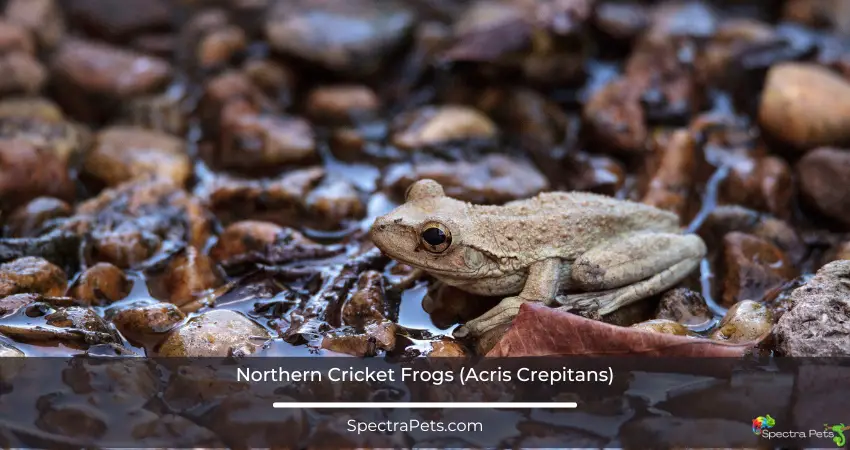
| Scientific Name | Acris crepitans |
| Adult Size | 0.75” – 1.5″ |
| Average lifespan | 5 – 10 years |
| Other Name | No |
| Family | Hylidae |
| Suitable for | Beginner level Frog Owner |
| Approx. Price | $10 – $20 |
Here is another tree frog who can’t climb trees properly. That’s why Northern cricket frogs are commonly seen near permanent water bodies like ponds and lakes which are filled with lots of vegetation. However, they tend to hibernate on higher lands that are situated far from the water.
You can easily identify these small creatures by the inconsistent blotching color patterns on their dorsal. These upper body color patterns include green, gray, and brown. Just like Southern cricket frogs, these amphibians also inherit bumpy skin. However, the Northern ones have shorter legs and more hind leg webbing compared to the Southern ones.
Despite having shorter legs, cricket frogs are capable of jumping about 3 feet high. This exceptional jumping ability helps them escape predators such as fish, birds, and other large frogs. They can also swim pretty well.
The main diet of these Northern species is various types of small insects. Unlike most tree frogs, they are not nocturnal animals. So, they remain active during the daytime and throughout the year. However, in winter, when the water becomes iced, they start hibernating in the uplands.
Moreover, May to July is the best time to breed for these diurnal species. During this time, male frogs create a high-pitched pebble-clicking sound to attract the opposite gender. The sound resembles the sound of a cricket. Therefore, you can easily understand why these frogs have such an interesting name.
12. Appalachian Mountain Chorus Frog
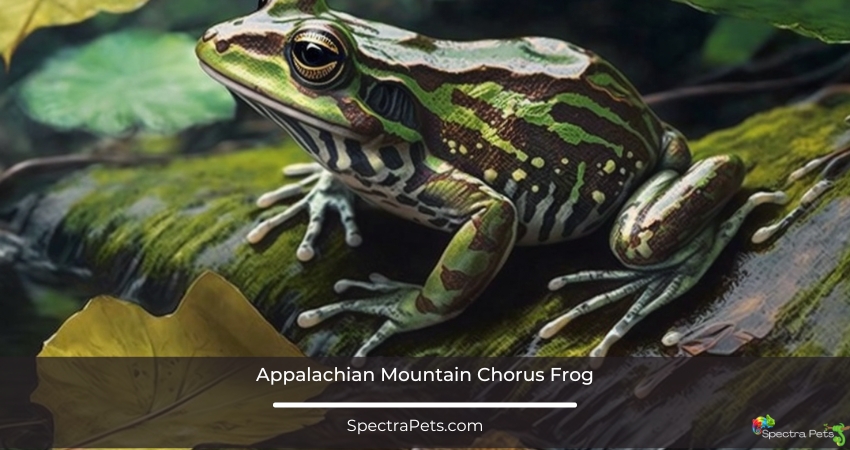
| Scientific Name | Pseudacris brachyphona |
| Adult Size | 1” – 1.4″ |
| Average lifespan | 1 – 3 years |
| Other Name | Mountain Chorus Frog |
| Family | Hylidae |
| Suitable for | Intermediate level Frog Owner |
| Approx. Price | Not found |
Appalachian mountain chorus frogs are one of the smallest amphibians found in North Carolina and this frog is endemic to the U.S.A. These eye-catching tree frogs prefer rivers, marshes, intermittent rivers, temperate forests, freshwater springs, swamps, ponds, ditches, and canals as their habitat.
In addition to that, these attractive species incorporate hues ranging from sorghum brown to mars brown to deep brownish-drab. With a stocky body, a triangular shape between two eyes, and a white line on the top lip, you shouldn’t have any problem recognizing these chorus frogs as soon as you see them.
Moreover, the females usually become slightly larger than male Appalachian mountain chorus frogs. The sound of their mating call is high-pitched, rapid, and nasally. It resembles the sound of a turning wagon wheel. They repeat the sound 50–70 times per minute and can call for up to 4–5 minutes continually. You can hear this unique call from half a mile away.
From February to April is their favorable breeding time, and they remain active both day and night. Also, these mountain chorus frogs like to take invertebrates as food. So, they hunt insects like small beetles, ants, spiders, caterpillars, grasshoppers, and so on.
13. Southern Chorus Frogs
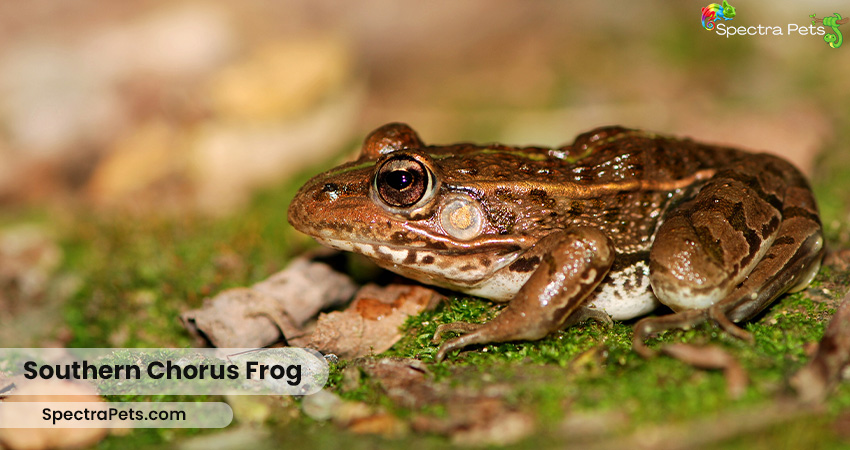
| Scientific Name | Pseudacris nigrita |
| Adult Size | 0.75” – 1.25″ |
| Average lifespan | 2 – 3 years |
| Other Name | No |
| Family | Hylidae |
| Suitable for | Intermediate level Frog Owner |
| Approx. Price | Not found |
A Southern Chorus Frog is often mistaken for an Upland Chorus Frog due to its similar appearance and call.
This small species of frog comes with a light tan or gray coloration, a whitish belly, tiny toe pads, and darkish brown stripes running along the sides of its body from its snout. Also, just like Appalachian mountain chorus frogs, they have a white line on the lip.
Moreover, Southern chorus frogs prefer to stay in Pinelands. They love to stay in the pinelands, especially for Pinelands’ sandy soil which enables them to burrow without any hassle.
However, they prefer temporary pools, flooded areas, shallow canals, and water-filled ditches when breeding time arrives. The most interesting fact about these frogs is that they call the female while hiding beneath grass, or small holes. Their breeding time spans from the end of winter to the start of spring.
These small tree climbers love to eat tiny insects, ants, and beetles. While they are nocturnal hunter, during dry seasons they often remain underground.
14. Brimley’s Chorus Frog

| Scientific Name | Pseudacris brimleyi |
| Adult Size | 1” – 1.3″ |
| Average lifespan | 1 – 3 years |
| Other Name | No |
| Family | Hylidae |
| Suitable for | Intermediate level Frog Owner |
| Approx. Price | Not found |
Brimley’s Chorus Frog is a small amphibian that is usually found in canals, artificial ponds, and cattle tanks. This special member of the tree frog family has blackish-brown stripes on both sides of its body and is tan in color.
A prominent dorsal strip and yellowish belly make these frogs easy to identify. These frogs also have brown spots on their chest. However, unlike other chorus frogs, Brimley’s Chorus frogs do not have triangular spots on their eyes.
Moreover, you will mostly hear them calling from December to April. They have a short, raspy call similar to that of other chorus frogs. These frogs prefer marshes, forests, swamps, and ditches for breeding. Their favorite food is small insects and invertebrates, such as flies, beetles, and ants.
The Brimley’s Chorus Frog is an Endangered species, and its numbers are believed to be decreasing. The main threat to the frog’s survival is habitat loss; as development continues in North Carolina, the areas where the frogs live are being destroyed.
Overall, This Chorus Frog is a fascinating creature, and it is hoped that efforts to protect its habitat will be successful so that this little amphibian can be saved from extinction.
15. Ornate Chorus Frog
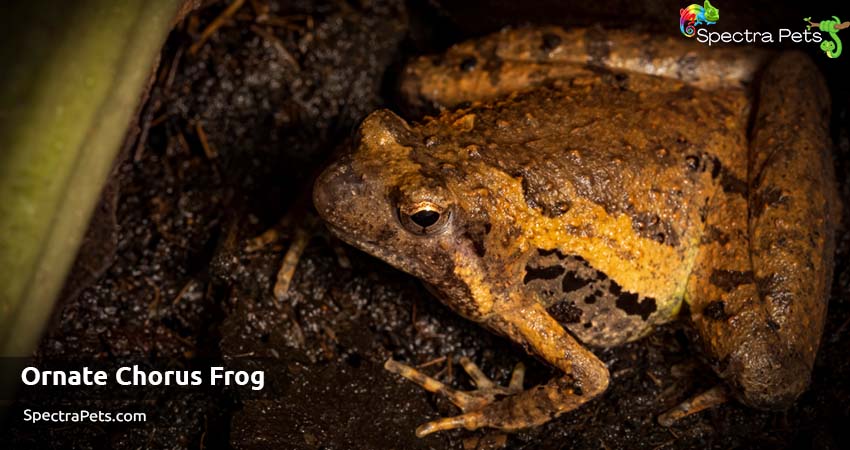
| Scientific Name | Pseudacris ornata |
| Adult Size | 1” – 1.5″ |
| Average lifespan | 1 – 3 years |
| Other Name | No |
| Family | Hylidae |
| Suitable for | Intermediate level Frog Owner |
| Approx. Price | Not found |
The Ornate Chorus Frog is a small but feisty creature that is found throughout the coastal plains of North Carolina.
Measuring in at just over an inch long, these frogs are easily distinguished by their red, green or brown bodies and the distinctive pattern of black spots that runs down their backs.
Ornate Chorus Frogs can be found in a variety of habitats, including woods, pine stands, marshes, sandhills, and even gardens. However, they typically breed in temporary ponds, roadside ditches, Woodland ponds, and flooded fields.
These frogs are nocturnal and you will notice their activity in the breeding season. That means, you will hear the repeated rasping sound of these frogs from December to march.
Small insects such as spiders, ants, flies, small beetles, and mites are their favorite food. Mostly snakes hunt these frogs, but birds and raccoons have also been known to prey upon them.
Although they are not currently considered to be endangered, the Ornate Chorus Frog faces threats from habitat loss and pollution.
16. Little Grass Frog
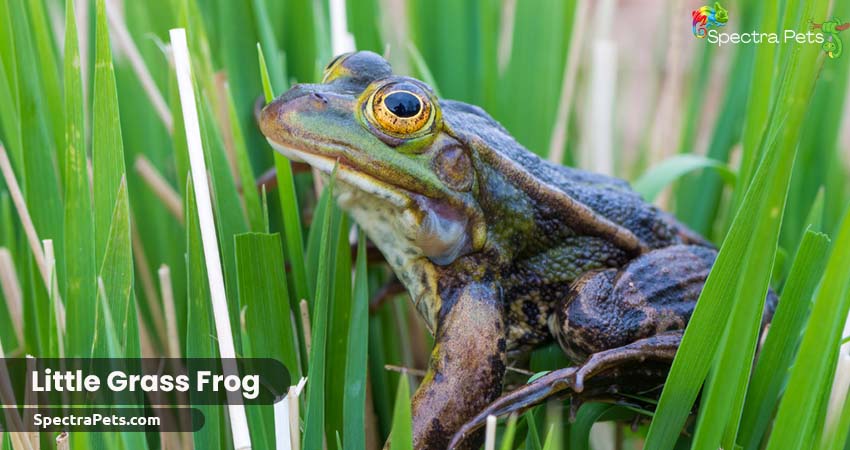
| Scientific Name | Pseudacris ocularis |
| Adult Size | 0.75″ |
| Average lifespan | 5 – 10 years |
| Other Name | No |
| Family | Hylidae |
| Suitable for | Advanced-level Frog Owner |
| Approx. Price | Not found |
Here is the last North Carolinian Tree Frog on the list and this beautiful creature is the tiniest frog found in the North American region. You will most probably see them jumping and hiding in temporary water features near the coastal plain as these small guys love to inhabit moist surroundings.
You can easily identify these species by their pointed snout, miniature size and tall legs. Though most of the little grass frogs are equipped with red to brown dorsal color, some of them have green, pink, and tan body color with various patterns. You will also notice a dark thick stripe running between its snout to the side of the body.
Surprisingly, this tree frog’s breeding time is very long. It spans from January to September. So, their high-pitched calls can be heard throughout the entire year. Usually, the females lay up to 200 eggs in shallow pond’s bottom and vegetated water bodies.
They prefer small insects and arthropods such as ants, springtails, and thrips. Their greatest strength is their ability to jump over 20 times higher than their height. By doing so, they are able to flee from any predator in a short amount of time.
Final Words
Amphibian enthusiast or not, one can’t help but be charmed by the tree frogs of North Carolina. With their vocal nature and wide array of colors, they are sure to make any summer night just a little bit more magical.
So next time you’re driving through the Tar Heel state, keep your eyes peeled for these special creatures. And maybe even give them a listen – you might be surprised at how much personality they have!
Tree Frogs Found in the Nearby States of North Carolina:

